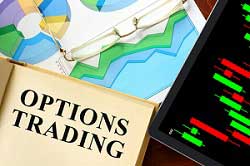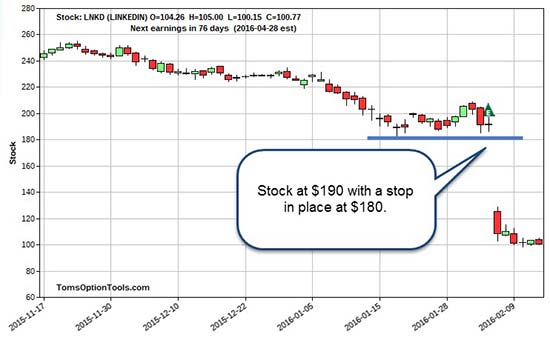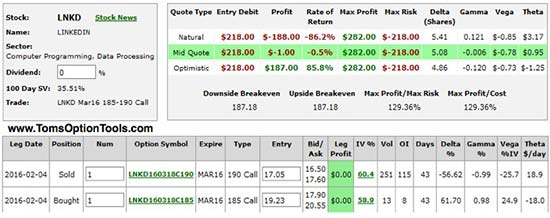The most basic principle of making money is not losing it.
If there's no way around that - then don't lose more than you make.
Now this may sound easy to do... but it isn't.
Sometimes trading can feel like a bet that's gone horribly wrong.
You put your money on the table, and the market takes it, having no intention of ever giving it back.
But there's one thing you should know that will set you apart from the trader who loses it all ...
How to utilize a "stop."
And I'm not talking about the one that the New York Stock Exchange is eliminating...
Forget the Stop and Good-til-Canceled Orders... Options Are Your Stop-Loss Protection
 Next week, on Feb. 26, the New York Stock Exchange (NYSE) will no longer accept stop orders and good-til-canceled (GTC) orders. A stop order is an order where the price is set above the underlying asset's (the stock's) current value (called a buy-stop order) or below its current value (called a sell-stop order). A GTC order is an order that stays open until it's filled or canceled by the trader.
Next week, on Feb. 26, the New York Stock Exchange (NYSE) will no longer accept stop orders and good-til-canceled (GTC) orders. A stop order is an order where the price is set above the underlying asset's (the stock's) current value (called a buy-stop order) or below its current value (called a sell-stop order). A GTC order is an order that stays open until it's filled or canceled by the trader.
A stop order is designed to limit the loss on a trade, while a GTC order allows you to wait and see if the trade is moving in your favor, allowing you to move on your position without a time restriction.
Now you can probably imagine why the NYSE's decision to eliminate these orders is causing traders to worry...
But we're going to talk about the one reason they shouldn't worry at all - and it's called options.
The beauty of trading options is that it offers a way to profit off of stock moves without having to shell out lofty amounts of cash to buy the stock itself.
Let's take a look at why...
Say you decide to buy 100 shares of a stock at $190 instead of buying one contract on a $190 call option that expires in one month. After buying the shares, the stock loses 80 points and drops down to $110 - giving you a loss in value of 47%. Now this may be an unrealized loss, but it's a loss nonetheless.
To make matters worse... let's say that the money you had to buy that stock was everything you had in your account. You're not only left down 47% on your trade... you've also just lost 47% of your entire account.
Now I want to stress that I am NOT an advocate of spending all you have on one trade. Even spending 50% to 60% of your account size on one trade is too much. But I've seen too many traders do this, which is why I want to talk about it.
In this case, you bet virtually all of the money in your account on one trade and lost half of it as a result.
But had you bought that call option, you would've only risked 9%. Even if you lost 100% of the premium, you would've risked only 9% of the full stock price down to zero.
And if you think that stocks don't go all the way down to zero... then tell that to anyone who invested in Lehman Brothers, as just one example.
The bottom line is...
There's Less Risk Trading Options Than Going Long on Stock
Buying an option inherently creates a built-in stop protection for your portfolio because of the reduced risk potential that exists in the old buy-and-hold strategy.
Look at LinkedIn Corp. (NYSE: LNKD), which has suffered a substantial drop...
Looking at this chart, I'm not too sure that investors are feeling great and saying "hey, at least it's not trading at zero."
Now you could buy 100 shares of the stock for a grand total of $19,000...
Or you could buy one March $190 call option (100 shares) and only spend $1,705.
Let's delve a little deeper using LNKD as our case study...
Post its earnings report, LNKD dropped to $110 and is now at around $105 per share.
But let's say you chose to go long the stock, adding a stop-loss order to sell the stock at the current market price once it hits or goes through the stop.
In this case, the stock never reached the $170 stop price and actually dropped to around $110. This means that the trade would have been stopped out at, say, $110, resulting in a loss of $80 per share - or $8,000.
The stop-limit order (an order to buy or sell stock at or above a certain price) would hurt you a bit more because it only would have stopped you if the stock hit that $170 price per share. If it gapped - as it did - then the stop limit at $170 would still be in place. This means that you would still own LNKD when it's trading at just $105.
And your loss potential?
Eighty-nine points - or $8,900.
Compare that to the loss you'd face on that March $190 call option - $1,705. The stock devalued by 47%, but the option (even if 100% of the loss is realized) is only down 9%.
The less experienced and ill-informed trader will spend money to buy the stock, using the stop order as "protection." However, the percentage loss of that stop may be a greater percentage loss to the portfolio than buying an option - even if the option loses 100%. This is because a 100% loss on the option may only result in a 2% to 3% loss of the overall portfolio.
And what's more is that the unrealized loss on the stock could be upwards of 40% to 60% of the portfolio if you're not careful and risk that much to begin with.
But the professional and savvy trader will look at the cost of the option, including even a 100% loss potential, as the overall risk to the portfolio. And the potential risk to the portfolio using an option strategy is much less than that of the buy-and-hold strategy.
Now you can reduce your risk even more buy creating a loophole trade, like the bull call spread below:
Rather than having the full $2,705 of the March $190 call at risk, you'd be risking $218, which is only a 1.1% risk of the $19,000 it would otherwise take to go long the 100 shares of LNKD.
Now what you'll want to avoid doing is spending as much money to buy a quantity of option contracts as you would on the stock itself.
But when you compare buying stock to buying options, you'll see that the option is your stop-order protection.
Follow Money Morning on Facebook and Twitter.
Why These Shares Are the Best for Trading Today: Traders are wizards at turning volatility into profits, but conventional tactics don't always work in this whipsaw market. In fact, there's a way to bank big gains on shares most people won't even touch right now - and it all comes down to one number...
About the Author
Tom Gentile, options trading specialist for Money Map Press, is widely known as America's No. 1 Pattern Trader thanks to his nearly 30 years of experience spotting lucrative patterns in options trading. Tom has taught over 300,000 traders his option trading secrets in a variety of settings, including seminars and workshops. He's also a bestselling author of eight books and training courses.






